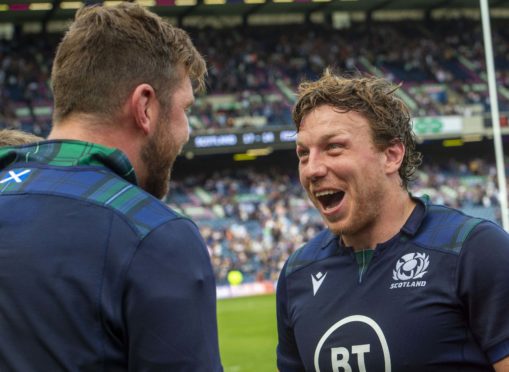Gregor Townsend still looked a little dissatisfied in the aftermath of the 17-14 victory over France that finally got some momentum into their preparation for the Rugby World Cup in Japan, but it wasn’t because his team hadn’t put on a circus act.
The narrow victory over a stronger French side to the one that had roundly thrashed Scotland in Nice was earned through basic rugby values – a strong scrummage, force in contact, stalwart defence and downright doggedness. Under Townsend, Scotland have shown these attributes plenty of times.
What gets more attention is when Finn Russell flings a ball behind his back or loops a pass over the heads of three defenders and the Scots play so-called “fairy-tale” rugby. Yes, the Scots do aspire to a quick and innovative game that will move other teams – usually much heavier teams – about the pitch, and Russell likes his tricks.
But to suggest that this is all they seek to do is spurious. Townsend and his coaching team are not so naïve not to understand that against certain teams and in certain environments, fairy-tale rugby isn’t going to cut it.
Every time –without exception – when Scotland have succeeded under Townsend and even going back to the last World Cup under Vern Cotter, it’s because the basics have been right – the defence has been strong, the collisions have come out at least equal, the setpiece has been sound and the attitude has been on point.
That foundation allows Scotland to do all the other stuff. Yes, even at Twickenham in March.
That game should essentially be treated as two – the first half debacle and the second half comeback.
But ignore the narrative of Russell changing the gameplan that day and chancing his arm – even in the pyrotechnics of scoring five tries in the second half, it happened because the Scottish basics had been recalibrated at half-time; the collisions were suddenly being won, the momentum from the forwards in carrying was positive, and the defence – finally – was doing its job.
So perhaps Townsend’s slight dissatisfaction on Saturday – “I don’t know where to rank that in terms of performance” – came from the basics being not quite right. The scrum was great but the lineout terrible, and Scotland made a lot of decision errors in open field play that cost them.
Still, from the low mark of Nice, it was a big step forward. France, with just four changes, didn’t look remotely like the well-drilled team they’d been in Nice, spilling the ball under force of contact time and again.
In addition, they didn’t create a whole lot in the game. Their two tries to get to a position of strength at 14-3 as time ticked toward half-time came from an interception by Damien Penaud of Pete Horne, and a counterattack against a mismatched defence after a terrible drop of a routine box-kick by Russell.
Scotland’s scores both came off French mistakes as well, but mistakes that were forced. France’s off-loading game was their downfall just before half-time, Chris Harris and Blair Kinghorn’s pressure forcing the turnover and after a couple of phases, Russell looping a miss-pass for Sean Maitland to score.
The second came from Scotland’s outstanding maul defence, inducing a fumble and then clearing up the tramlines to take play from one 22 to the other. A couple of setpieces and some charges later, Grieg Laidlaw picked Chris Harris coming from deep on an angle for the simplest of tries under the posts.
Scotland probably should have won going away in the last quarter, but their open attacking game looked a little gun-shy. That’s probably okay, because it’ll be the last thing to be ready prior to flying to Japan and the next two games against Georgia – certainly in Tbilisi next week – are going to be physical challenges.
The defence however stayed sound – even with the awkward reshuffle on Sam Skinner’s injury – and the Scots were able to shrug off the odd lineout malfunction.
There is probably an easy fix for the lineout issue, but involves swallowing some pride and calling up Richie Gray, which the management team are unlikely to do. It’s more likely they’ll stick with some drills, and give Ben Toolis another chance in Georgia.
As for the rest, apart from the couple of errors that caused the French tries, it was all fairly solid. Laidlaw piloted the team as we know he can do, Russell slowly came on to a good game as it went on, and Harris put down an unexpected marker. WP Nel should be encased in bubble wrap until Ireland in Yokohama on September 23.
But Scotland really got it right in the back row, where Ryan Wilson brought his usual edge, Blade Thomson was pretty much as had been advertised, John Barclay looked right up to speed when he came on, and Hamish Watson was worth every bit of his man of the match award.
In carrying, in tackling, in foraging for ball, the dynamic open-side is a game changer, and every bit as important to Scotland’s game plan as Russell or anyone else.


